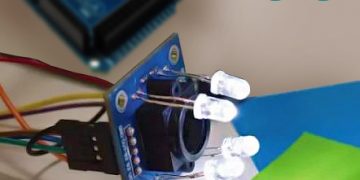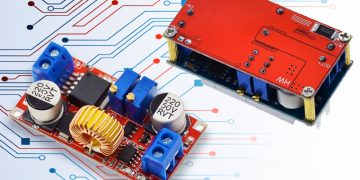در این پروژه می خواهم با استفاده از LED نواری ، آردوینو و ماژول میکروفن Max4466 یک رقص نور موزیکال طراحی کنم.
من به نور و رنگها و موسیقی علاقه زیادی دارم، به همین دلیل تصمیم به ساخت این پروژه گرفتم.
در فیلم زیر رقص نور موزیکال طراحی شده، نمایش داده شده است.
لینک دانلود عملکرد رقص نور موزیکال
شرح پروژه رقص نور موزیکال با LED نواری
طراحی این پروژه بسیار ساده است و به راحتی می توانید یک رقص نور موزیکال با نوار LED طراحی کنید. من از ماژول آردوینو نانو (Arduino Nano) به عنوان میکروکنترلر مدار استفاده کرده ام. از کتابخانه FFT برای تبدیل صدا به اُکتاو، کتابخانه FASTLed برای کنترل حرکت چراغها در LED نواری و یک جعبه iPhone C برای قرار دادن کل مدار در آن، استفاده کرده ام.
نمودار شماتیک مدار
ویژگی های مدار LED نواری
برای کنترل میزان صدا از یک پتانسیومتر تریمر خوابیده 10kOhm استفاده کرده ام.
ماژول میکروفن استفاده شده در مدار نسبت به نویز حساس است، به همین دلیل سیمها را با چسب نواری آلومینیومی پوشانده ام.
عملکرد LED نواری
1) رنگ، روشنایی و سرعت حرکت چراغها بر اساس هر اُکتاو تغییر می کند.
2) همان 11 الگوی LED نواری ، دائماً در نوار تکرار می شود (اما تغییر رنگ ها موجب می شود تا تصور کنید که الگو دائماً تغییر می کند).
3) هرچه صدا بلندتر شود، روشنایی چراغها بیشتر می شود و الگو با سرعت بیشتری ادامه پیدا می کند.
4) وقتیکه صدا در بلندترین حالت قرار بگیرد، نور چراغها کاملا سفید می شود.
برای برق رسانی به مدار از یک آداپتور 12 ولت/1.5 آمپر دیواری به عنوان منبع تغذیه استفاده کرده ام. هر چند که قدرت پایینی دارد ولی برای این مدار مناسب است. البته به نظر من اگر می توانید هزینه بیشتری بکنید، بهتر است که از یک آداپتور 12 ولت/2 آمپر استفاده کنید. همچنین، به جای استفاده از خازن 470 uF می توانید از یک خازن بزرگتر در منبع تغذیه ای که به ال ای دی ها متصل است، استفاده کنید.
همانطور که در تصویر زیر می بینید این پروژه به طور کلی به سه بخش تقسیم می شود: آداپتور دیواری ، جعبه نگدارنده مدار و LED نواری
محتویات جعبه iPhone C
همانند تصویر زیر، تمام قطعات را روی یک برد بورد و با استفاده از چسب حرارتی درون یک جعبه iPhone C لحیم کرده ام.
کد پروژه
#include "FastLED.h"
// How many leds in your strip?
#include <FastLED.h>
#define OCTAVE 1 // // Group buckets into octaves (use the log output function LOG_OUT 1)
#define OCT_NORM 0 // Don't normalise octave intensities by number of bins
#define FHT_N 256 // set to 256 point fht
#include <FHT.h> // include the library
//int noise[] = {204,188,68,73,150,98,88,68}; // noise level determined by playing pink noise and seeing levels [trial and error]{204,188,68,73,150,98,88,68}
// int noise[] = {204,190,108,85,65,65,55,60}; // noise for mega adk
//int noise[] = {204,195,100,90,85,80,75,75}; // noise for NANO
int noise[] = {204,198,100,85,85,80,80,80};
float noise_fact[] = {15, 7, 1.5, 1, 1.2, 1.4, 1.7,3}; // noise level determined by playing pink noise and seeing levels [trial and error]{204,188,68,73,150,98,88,68}
float noise_fact_adj[] = {15, 7, 1.5, 1, 1.2, 1.4, 1.7,3}; // noise level determined by playing pink noise and seeing levels [trial and error]{204,188,68,73,150,98,88,68}
#define LED_PIN 5
#define LED_TYPE WS2811
#define COLOR_ORDER GRB
// Params for width and height
const uint8_t kMatrixWidth = 11;
const uint8_t kMatrixHeight = 27;
#define NUM_LEDS (kMatrixWidth * kMatrixHeight)
//#define NUM_LEDS 15
CRGB leds[NUM_LEDS];
int counter2=0;
void setup() {
// Serial.begin(115200);
delay(1000);
FastLED.addLeds<LED_TYPE, LED_PIN, COLOR_ORDER>(leds, NUM_LEDS).setCorrection( TypicalLEDStrip );
FastLED.setBrightness (200);
fill_solid(leds, NUM_LEDS, CRGB::Black);
FastLED.show();
// TIMSK0 = 0; // turn off timer0 for lower jitter
ADCSRA = 0xe5; // set the adc to free running mode
ADMUX = 0x40; // use adc0
DIDR0 = 0x01; // turn off the digital input for adc0
}
void loop() {
int prev_j[8];
int beat=0;
int prev_oct_j;
int counter=0;
int prev_beat=0;
int led_index=0;
int saturation=0;
int saturation_prev=0;
int brightness=0;
int brightness_prev=0;
while (1) { // reduces jitter
cli(); // UDRE interrupt slows this way down on arduino1.0
for (int i = 0 ; i < FHT_N ; i++) { // save 256 samples
while (!(ADCSRA & 0x10)); // wait for adc to be ready
ADCSRA = 0xf5; // restart adc
byte m = ADCL; // fetch adc data
byte j = ADCH;
int k = (j << 8) | m; // form into an int
k -= 0x0200; // form into a signed int
k <<= 6; // form into a 16b signed int
fht_input[i] = k; // put real data into bins
}
fht_window(); // window the data for better frequency response
fht_reorder(); // reorder the data before doing the fht
fht_run(); // process the data in the fht
fht_mag_octave(); // take the output of the fht fht_mag_log()
// every 50th loop, adjust the volume accourding to the value on A2 (Pot)
if (counter >= 50) {
ADMUX = 0x40 | (1 & 0x07); // set admux to look at Analogpin A1 - Master Volume
while (!(ADCSRA & 0x10)); // wait for adc to be ready
ADCSRA = 0xf5; // restart adc
delay(10);
while (!(ADCSRA & 0x10)); // wait for adc to be ready
ADCSRA = 0xf5; // restart adc
byte m = ADCL; // fetch adc data
byte j = ADCH;
int k = (j << 8) | m; // form into an int
float master_volume=(k+0.1)/1000 +.5; // so the valu will be between ~0.5 and 1.5
// Serial.println (master_volume);
for (int i=1; i<8; i++) {
noise_fact_adj[i]=noise_fact[i]*master_volume;
}
ADMUX = 0x40 | (0 & 0x07); // set admux back to look at A0 analog pin (to read the microphone input
counter = 0;
}
sei();
counter++;
// End of Fourier Transform code - output is stored in fht_oct_out[i].
// i=0-7 frequency (octave) bins (don't use 0 or 1), fht_oct_out[1]= amplitude of frequency for bin 1
// for loop a) removes background noise average and takes absolute value b) low / high pass filter as still very noisy
// c) maps amplitude of octave to a colour between blue and red d) sets pixel colour to amplitude of each frequency (octave)
for (int i = 1; i < 8; i++) { // goes through each octave. skip the first 1, which is not useful
int j;
j = (fht_oct_out[i] - noise[i]); // take the pink noise average level out, take the asbolute value to avoid negative numbers
if (j<10) {j=0;}
j= j*noise_fact_adj[i];
if (j<10) {j=0;}
else {
j= j*noise_fact_adj[i];
if (j>180) {
if (i>=7) {
beat+=2;
}
else {
beat+=1;
}
}
j=j/30;
j=j*30; // (force it to more discrete values)
}
prev_j[i]=j;
// Serial.print(j);
// Serial.print(" ");
// this fills in 11 LED's with interpolated values between each of the 8 OCT values
if (i>=2) {
led_index=2*i-3;
prev_oct_j=(j+prev_j[i-1])/2;
saturation=constrain(j+30, 0,255);
saturation_prev=constrain(prev_oct_j+30, 0,255);
brightness=constrain(j, 0,255);
brightness_prev=constrain(prev_oct_j, 0,255);
if (brightness==255) {
saturation=50;
brightness=200;
}
if (brightness_prev==255) {
saturation_prev=50;
brightness_prev=200;
}
for (uint8_t y=0;y<kMatrixHeight;y++){
leds[XY(led_index-1,y)] = CHSV(j+y*30,saturation, brightness);
if (i>2){
prev_oct_j=(j+prev_j[i-1])/2;
leds[ XY(led_index-2,y)]=CHSV(prev_oct_j+y*30,saturation_prev, brightness_prev);
}
}
}
}
if (beat>=7) {
fill_solid(leds, NUM_LEDS, CRGB::Gray);
FastLED.setBrightness(120);
// FastLED.setBrightness(200);
}
else {
if (prev_beat!=beat) {
FastLED.setBrightness(40+beat*beat*5);
prev_beat=beat;
}
}
FastLED.show();
if (beat) {
counter2+=((beat+4)/2-2);
if (counter2<0) {counter2=1000;}
if (beat>3 && beat<7) {
FastLED.delay (20);
}
beat=0;
}
// Serial.println();
}
}
// Param for different pixel layouts
const bool kMatrixSerpentineLayout = true;
// Set 'kMatrixSerpentineLayout' to false if your pixels are
// laid out all running the same way, like this:
// Set 'kMatrixSerpentineLayout' to true if your pixels are
// laid out back-and-forth, like this:
uint16_t XY( uint8_t x, uint8_t y)
{
uint16_t i;
if( kMatrixSerpentineLayout == false) {
i = (y * kMatrixWidth) + x;
}
if( kMatrixSerpentineLayout == true) {
if( y & 0x01) {
// Odd rows run backwards
uint8_t reverseX = (kMatrixWidth - 1) - x;
i = (y * kMatrixWidth) + reverseX;
} else {
// Even rows run forwards
i = (y * kMatrixWidth) + x;
}
}
i=(i+counter2)%NUM_LEDS;
return i;
}
قطعات و نرم افزار مورد نیاز
- Arduino Nano R3
- WS2812B LED Strip
- Adafruit Electret Microphone / Max4466 Amplifier
- Single Turn Potentiometer- 10k ohms
- Tobsun 5V DC-DC Converter
- 12V 1.5A DC power supply
- Soldering iron (generic)
- Arduino IDE








سلام. چطور میتوانم این محصول را به صورت آماده و حتی آزمایشی تهیه کنم.
سلام دوست عزیز
شما می توانید این محصول رو از طریق فروشگاه های آنلاین معتبر و با سرچ در گوگل به راحتی تهیه کنید.